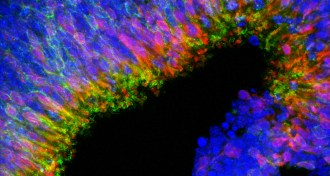
Senior writer Tina Hesman Saey is a geneticist-turned-science writer who covers all things microscopic and a few too big to be viewed under a microscope. She is an honors graduate of the University of Nebraska-Lincoln where she did research on tobacco plants and ethanol-producing bacteria. She spent a year as a Fulbright scholar at the Georg-August University in Göttingen, Germany, studying microbiology and traveling. Her work on how yeast turn on and off one gene earned her a Ph.D. in molecular genetics at Washington University in St. Louis. Tina then rounded out her degree collection with a master’s in science journalism from Boston University. She interned at the Dallas Morning News and Science News before returning to St. Louis to cover biotechnology, genetics and medical science for the St. Louis Post-Dispatch. After a seven year stint as a newspaper reporter, she returned to Science News. Her work has been honored by the National Academies of Sciences, Engineering and Medicine, the Endocrine Society, the Genetics Society of America and by journalism organizations.

Trustworthy journalism comes at a price.
Scientists and journalists share a core belief in questioning, observing and verifying to reach the truth. Science News reports on crucial research and discovery across science disciplines. We need your financial support to make it happen – every contribution makes a difference.
All Stories by Tina Hesman Saey
-
 Genetics
GeneticsGenes for body symmetry may also control handedness
Lefties and righties can thank same genes that put hearts on left side for hand dominance, study of thousands of people’s DNA suggests.
-
 Health & Medicine
Health & MedicineAlzheimer’s disease protein structure may vary among patients
Two people with different symptoms had amyloid-beta fibers with different shapes.
-
 Life
LifeFlu antibodies can make disease worse
Pigs vaccinated against one influenza virus got lung damage if infected with another strain.
-
 Life
LifeBats can carry MERS
DNA of a deadly respiratory virus has been found in a Saudi Arabian mammal.
-
 Life
LifeYears or decades later, flu exposure still prompts immunity
New forms of influenza viruses can spur production of antibodies to past pandemics in people who lived through them.
-
 Health & Medicine
Health & MedicineMediterranean diet may offset genetic risk for stroke
Compared to a low-fat diet, eating fish and olive oil kept blood sugar levels lower in people with a common diabetes risk factor.
-
 Humans
HumansDNA reveals details of the peopling of the Americas
Migrants came in three distinct waves that interbred once in the New World.
-

-
 Health & Medicine
Health & MedicineCamels implicated as possible hosts of MERS virus
Antibodies to a mysterious pathogen that has sickened 94 people were found in camels in Oman and the Canary Islands.
-
 Science & Society
Science & SocietyFlu researchers plan to repeat controversial work
The scientists who made the H5N1 strain transmissible between ferrets intend to do the same with H7N9.
-

-
